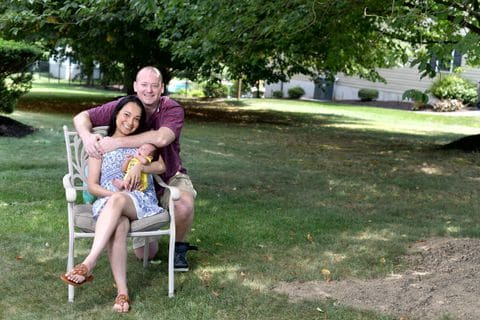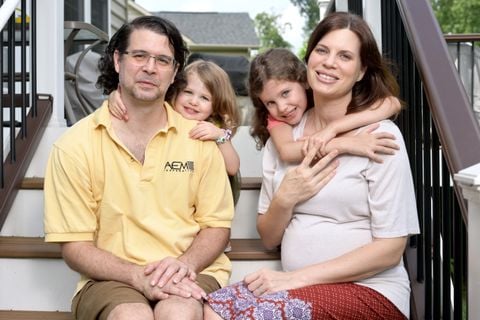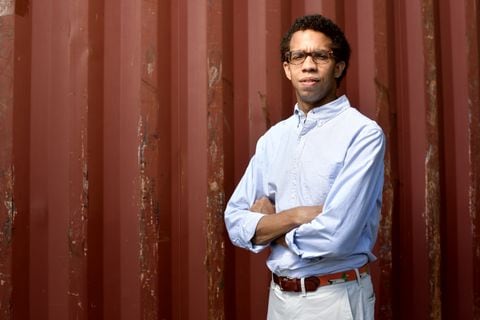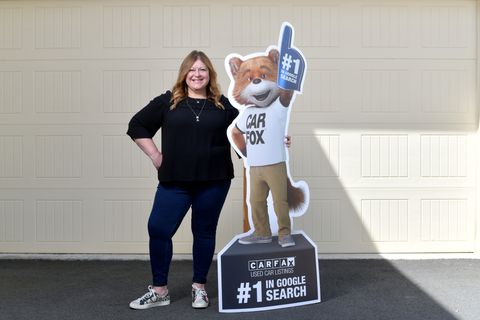At work while at home: The new paradigm
Linda Miller has found a happy medium.
She lives in Warrenton, Va., which puts her right in between her job as an executive assistant at the economic consulting firm Bates White in Northwest Washington and her 86-year-old parents’ home in Harrisonburg, Va. Before the novel coronavirus forced many workers out of the office, Miller would drive to Harrisonburg once or twice a month and arrive at her parents’ by 8 a.m. to start working remotely. There were days when Miller would stop working at 9 p.m. or midnight if she started later, but her superiors never seemed to mind.
“I feel like I can be just as responsive [working remotely],” Miller said. “I would log into the Bates White computer system while standing at my mom’s kitchen counter and answer emails or work on a project while cooking my dad breakfast, looking over their monthly bills or answering one of a thousand ‘should we’-type questions.”
 Linda Miller stands next to her mother. Miller has worked at Bates White as an executive assistant in its mergers practice for the past three years. (Michael McCoy for The Washington Post)
Linda Miller stands next to her mother. Miller has worked at Bates White as an executive assistant in its mergers practice for the past three years. (Michael McCoy for The Washington Post) Her mother’s health is amazing but her father has struggled with his speech since he suffered a massive stroke six years ago, she said. Miller’s husband has battled heart problems, diabetes and insomnia, and her brother underwent a triple bypass surgery in January. The health issues within her immediate family would be enough to overwhelm Miller, if she hadn’t found the happy medium between her work and home lives.
“Bates White is never going to say, in my mind, that your spouse or your family is secondary, they’re always going to say your family is first,” she said. “Work is work and work needs to be fun, but work doesn’t own you. It needs to be a place where you can enjoy the people. You need to never forget that you come home to [your] family.”
Millions of workers like Miller are rethinking the rat-race approach to employment and prioritizing time to care for family, friends, their community and themselves. Companies competing for the best employees have taken note, upping the ante with innovative benefits like subsidized elder care, paid time off for volunteering, treadmill desks and wellness rooms.
 Miller’s mother’s health is amazing, but her father suffered a stroke six years ago, and her husband has battled heart problems, diabetes and insomnia. (Michael McCoy for The Washington Post)
Miller’s mother’s health is amazing, but her father suffered a stroke six years ago, and her husband has battled heart problems, diabetes and insomnia. (Michael McCoy for The Washington Post) Yet the holy grail of employee benefits — flexible schedules — has fallen from the gold standard to a basic offering as the coronavirus compelled companies to allow their employees to work from home and grant them the leeway to manage household responsibilities while on the clock. It’s not unheard of now for bosses to drop a note over Slack that they’re stepping out to grab groceries during the workday or for employees to step away from their home office to attend to a precocious kindergartner.
“What the covid situation has done is demonstrated how much more creative and flexible workplaces can be,” said Michelle McQuaid, director of the Wellbeing Lab, an international consortium of workplace wellness experts. Employees always dealt with mental and physical health struggles on top of work, but the pandemic has pushed those issues to the forefront of employers’ minds, she added.
“Right now is a great time for workplaces to be having this conversation because we still face months of disruption. The need for this has always been great, it’s so heightened and visible right now, she said.
Some of The Washington Post’s Top Workplaces were already on track to give their employees more flexibility before the coronavirus upended the physical barriers between work and home.
 Nicole Noronha, 31, a recruiting coordinator and a new mother, sits with her husband, Ryan Kearney, and their son, Nolan Kearney. (Marvin Joseph/The Washington Post)
Nicole Noronha, 31, a recruiting coordinator and a new mother, sits with her husband, Ryan Kearney, and their son, Nolan Kearney. (Marvin Joseph/The Washington Post) Nicole Noronha, a 31-year-old recruiting coordinator at the law firm Sterne, Kessler, Goldstein & Fox and a new mother, was already working from home before the pandemic hit as part of a pilot program that tested remote work with about two dozen of Sterne Kessler’s 400 employees. For Noronha, Sterne Kessler’s willingness to try out flexible schedules fit in with her idea of her workplace’s culture.
“When I applied for the job, I was getting married pretty soon,” she said. “It was totally taken in stride; they told me I could take the time I needed.”
Noronha had never worked remotely at previous law firms and was allowed to select up to two days a week to work from home. She saved time and money on the commute from Takoma, a neighborhood in Washington, D.C., to downtown Washington, and felt more productive and energetic working from home.
“One of the downsides, you miss the face-to-face time with your colleagues,” she said.
The work-from-home pilot helped Noronha hit the ground running during the stay-at-home directive. Since mid-March she has stayed with her family in West Chester, Pa., while her husband, an emergency room nurse at George Washington University Hospital, stayed at their home in Takoma so they could limit any exposure during her pregnancy.
Her son was born six weeks early while she was in Pennsylvania. Her plans to return to Takoma are on hold until the pandemic is under control but she returned to remote work in early September.
“We thought it was for the best and I feel like I’ve been fortunate,” she said. “As soon as I spoke to my supervisor, it was never an issue at all.”
 Millie Parikh works on the services and innovation team at Eagle Hill Consulting. She has a 10-month-old baby, a 3-year-old and her husband is a doctor on the front lines. (Marvin Joseph/The Washington Post)
Millie Parikh works on the services and innovation team at Eagle Hill Consulting. She has a 10-month-old baby, a 3-year-old and her husband is a doctor on the front lines. (Marvin Joseph/The Washington Post) Millie Parikh, whose husband is also working on the front lines as a physician in Manassas, Va., has enjoyed her flexible schedule while she takes care of her children, ages 1 and 3. A senior manager at Eagle Hill Consulting, she discovered her employer through The Post’s Top Workplace rankings.
“For me, the biggest draw was the culture,” Parikh said. “I don’t think the feeling of missing your kids ever goes away. Especially being a new mom, it makes me feel better.”
Like Miller, Parikh thinks of her job and home lives as less of a work-life balance and more of a work-life flexibility. As a new mother, she relishes the opportunity to get up early, make a cup of coffee and spend time with her infant.
“I always talk about work-life flexibility: getting your work done with autonomy, as long as you’re meeting your client obligations, you work at your own pace, you work at different locations,” she said. “I don’t mind getting online at the end of the evening because it’s something I wanted to do, so that for me is more important than the work-life balance piece of things at this stage in my career, autonomy is the most important thing at this time with covid.”
While work-from-home rehearsals prepared office workers for an unprecedented event, the flexible schedule concept can’t be applied across the board, according to Stewart Friedman, a professor at the Wharton School at the University of Pennsylvania and author of “Parents Who Lead: The Leadership Approach You Need to Parent with Purpose, Fuel Your Career, and Create a Richer Life.”
“The thing we know about flexible work arrangements is that there’s no one best way. Our lives are different,” Friedman said. “One of the things that’s emerging in our Zoom life is that I can see your house, which gives me insight beyond the work role. There’s a greater understanding of how people are living.”
The phrase “work-life balance” may be a misnomer, one that’s rooted in the idea that workers must make trade-offs between their responsibilities at their job and their happiness at home. Friedman takes a different approach. In 1991, he founded Wharton’s Work/Life Integration Project with the goal of teaching workers and employers how to blend work, home, community and self. He argues that the term “balance” is not only misguided but destructive.
“The term integration is more useful because it suggests the great challenge is to create some harmony at different times,” Friedman said.
Kathleen Gerson, a professor of sociology at New York University who began researching work-life integration around the same time as Friedman, agrees that a work-life convergence is healthier than trying to stabilize a precarious teeter-totter. She’s also noticed how the conversation around work and life has evolved into a more inclusionary discussion that considers both men and women.
“What I’ve watched happen is the questions we asked have changed as the problems we face have changed,” she said. “We moved from this is a woman’s problem to this is everyone’s problem. They’re certainly men’s issues as well.”
More employers are espousing a healthy work-life balance that benefits both male and female workers. In addition to nursing rooms for new mothers, Carfax boasts enriched “time off benefits with an upgraded paternity leave, giving new parents up to 26 weeks off without using vacation time.”
The concept of work-life balance has its roots in female workers’ struggle for parity. The buzzword emerged in the 1990s, as women rose to prominence in the workforce and claimed executive positions traditionally held by men. At the same time, domestic demands haven’t decreased for women.
In fact, parents are spending more time with their children today than they did at the height of the nuclear family in the mid-1960s, according to a 2016 study from the University of California at Irvine. Mothers doubled their time with their children from 54 minutes per day in 1965 to 104 minutes per day in 2012, the study reported. Fathers quadrupled their child-care time from 16 to 59 minutes per day.
“The paradox is just as the need for more balance has arisen, we have increasing cultural and institutional pressures to put more time at work and with our families,” Gerson said. “I find it ironic to an extreme that just as women have become integral to the workplace and families depend on women’s as well as men’s earnings . . . you’d think the logical response would be to pull back on the number of hours and to lower those standards a bit to make room for time for everyone to take care of all of those activities.”
 Doreen and Kirk Faye, sitting with daughters Juliet, 3, and Leah, 6, both work at AEM Corp on separate federal contracts. (Marvin Joseph/The Washington Post)
Doreen and Kirk Faye, sitting with daughters Juliet, 3, and Leah, 6, both work at AEM Corp on separate federal contracts. (Marvin Joseph/The Washington Post) Doreen and Kirk Faye, a married couple who both work at Herndon, Va.-based consulting firm AEM Corp. on separate federal contracts, have figured out a healthy balance between work and family thanks in part to the leadership at their company. They have two daughters, ages 3 and 6, and are expecting another child later this year.
Doreen started at AEM 17 years ago after graduating from William and Mary. She was waiting tables in 2003 when she started a part-time administrative position that evolved into a full-time job and later contract work. She met Kirk while working on a three-week defense contract in Naples, in May of 2006.
“I think it’s hard not to fall into love in Italy in the springtime,” she said. “We’re actually one of several married couples; I think that does speak a lot for the company.”
When the two were commuting back and forth between their office and their children’s schools, they would often tag-team drop-off and pickup duty. That emphasis on a flexible schedule that allows time for families comes straight from AEM’s founder, Sharon deMonsabert, Doreen said. Beyond the concrete provisions in AEM’s benefits package, deMonsabert’s personal touch has sent a positive message to her employees.
“From a benefits package standpoint, [deMonsabert] definitely values family considerations,” Kirk added. “She supports a lot of events, we do a family picnic . . . just the way she treats people, she knows everybody by name, she makes the decision for all hiring.”
Caretaking doesn’t just apply to couples with children. Gerson finds that those who have opted out of marriage or parenthood are especially likely to care for parents and other family members.
“It’s a big mistake to think that someone who might not have their own biological child does not have caretaking duties,” Gerson said. “Family well-being is of course fundamental but it shouldn’t be exclusionary. The reason I think it’s getting traction is the rising demands on workers and the increasing precariousness of work if you don’t put in more time.”
 Al Wilkins, 35, has worked at EAB for 13 years. (Marvin Joseph/The Washington Post)
Al Wilkins, 35, has worked at EAB for 13 years. (Marvin Joseph/The Washington Post) Al Wilkins is a 35-year-old senior director at EAB, a D.C.-based research and consulting firm where he has worked for 13 years. In 2018, he traveled to Orlando for a few days to visit his sick mother. After she was diagnosed with stage four appendix cancer, Wilkins spent the next three months working from Florida so he could care for her until she died that December.
“Throughout my time in Florida, my manager and team were extremely flexible,” he said. “I had a new manager and we were developing a relationship when I suddenly had to move. She was compassionate, encouraging and led with empathy. She even visited me at Thanksgiving and attended my mother’s funeral.”
As a single man, Wilkins uses much of his time after and sometimes during work to care for those in his community. When he manages young professionals at EAB, he’ll often highlight the company’s community impact program, which offers paid time off to volunteer. His office not only allows employees to volunteer but also encourages it. When Wilkins started volunteering during dinner services at Community of Hope, a nonprofit aiding low-income, homeless and underserved families in Washington, D.C., his manager asked about his time and if he could share highlights with his co-workers.
 Tracey Holupka is a brand strategy and research lead at Carfax in Centreville, Va. (Marvin Joseph/The Washington Post)
Tracey Holupka is a brand strategy and research lead at Carfax in Centreville, Va. (Marvin Joseph/The Washington Post) Tracey Holupka, a brand strategy and research lead at Carfax in Centreville, Va., has also carved out time outside of work to help members of her community, albeit the four-legged ones. Holupka often worked from home before the pandemic to ease her from debilitating migraines. Her cheerful, Pinterest-worthy home office comes with the added benefit of extra time with Doug, a pit bull-mix with a neurodegenerative disease and one of several animals Holupka has rescued or fostered over the years.
“The ones that find me are the ones that have a lot of health issues,” she said. “I pretty much have only special-needs dogs.”
When she did come to the office, Holupka was always able to bring Doug or any of her other pets. Carfax President Dick Raines, who owns a dog named Bailey, negotiated with the office building’s management to allow pets four years ago.
“There are not as many kids [in the office] as dogs,” she said. “But there are certainly times when child care falls through. Bringing your kid to work is stressful, but not at Carfax, because you have the option to work from home” during normal times.
For white-collar workers in the “knowledge economy,” the pandemic may have shifted the balance in their favor. Bosses who once hesitated or even prohibited their employees from working from home now have little evidence that work can’t get done remotely.
“The pandemic life is overcoming the resistance that has been felt forever, I don’t see that going back, at least for knowledge workers,” said Friedman. “I am hopeful, I want that to be some of the good that comes out of this, assuming that we survive. Professional services firms are wondering if we need to be paying these real estate costs and commuting costs. There’s huge cost savings to a more hybrid life.”






